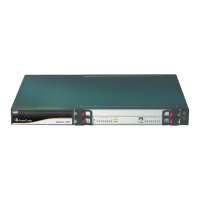Version 7.0 549 Mediant 3000
User's Manual 28. SBC Overview
28.2 B2BUA and Stateful Proxy Operating Modes
The device can operate in one or both of the following SBC modes:
Back-to-Back User Agent (B2BUA): Maintains independent sessions toward the
endpoints, processing an incoming request as a user agent server (UAS) on the
inbound leg, and processing the outgoing request as a user agent client (UAC) on the
outbound leg. SIP messages are modified regarding headers between the legs and all
the device's interworking features may be applied.
Stateful Proxy Server: SIP messages traverse the device transparently (with minimal
interference) between the inbound and outbound legs, for connecting SIP endpoints.
By default, the device's B2BUA mode changes SIP dialog identifiers and topology data in
SIP messages traversing through it:
Call identifiers: Replaces the From-header tag and Call-ID header so that they are
different for each leg (inbound and outbound).
Routing headers:
• Removes all Via headers in incoming requests and sends the outgoing message
with its own Via header.
• Doesn't forward any Record-Route headers from the inbound to outbound leg,
and vice versa.
• Replaces the address of the Contact header in the incoming message with its
own address in the outgoing message.
Replaces the User-Agent/ Server header value in the outgoing message, and replaces
the original value with itself in the incoming message.
In contrast, when the device operates in Stateful Proxy mode, the device by default
forwards SIP messages transparently (unchanged) between SIP endpoints (from inbound
to outbound legs). The device retains the SIP dialog identifiers and topology headers
received in the incoming message and sends them as is in the outgoing message. The
device handles the above mentioned headers transparently (i.e., they remain unchanged)
or according to configuration (enabling partial transparency), and only adds itself as the
top-most Via header and optionally, to the Record-Route list. For configuring the handling
of these headers for partial transparency, use the following IP Profile parameters (see
''Configuring IP Profiles'' on page 391):
IpProfile_SBCRemoteRepresentationMode: Contact and Record-Route headers
IpProfile_SBCKeepVIAHeaders: Via headers
IpProfile_SBCKeepUserAgentHeader: User-Agent headers
IpProfile_SBCKeepRoutingHeaders: Record-Route headers
IpProfile_SBCRemoteMultipleEarlyDialogs: To-header tags

